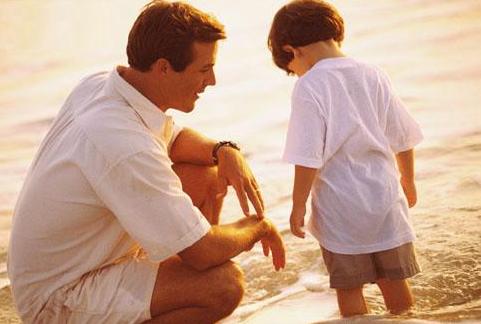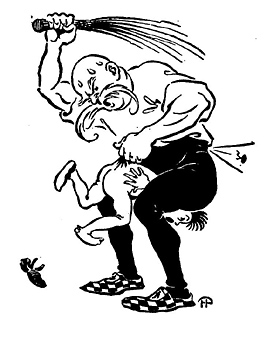 Ever thought about what you would do when you're alone with a dear little gram and something "occurs" that requires a "Teaching Moment"
Ever thought about what you would do when you're alone with a dear little gram and something "occurs" that requires a "Teaching Moment"Can I be any more indirect?
Suppose little Johnny, (age 4 to 6) has climbed up the mantle and willfully thrown off one of Gramma's heirloom vases during an overnight visit at Grampa's House.
What does a good Grampa Do? (Remember parents aren't there. The situation requires some behavior modification.)
There are a number of right answers, but here's one technique that modern parents and gramparents (2010) seem to favor.
TIME OUT
Dr. Brian Pead, currently Administrator of Davis School District in Layton) had a little antique deacons bench in the entry hall away from the rest of the house. He used it with his younger kids from the time they could grasp right and wrong.
1. He sat with them on the little bench and discussed the situation in calm and loving terms encouraging them to talk about what happened - all in loving neutral terms without using right or wrong labels.
2. He asked the child how he felt about what happened and gently waited for responses. (Calmly talking about it encourages introspection and clear communication) Sometimes another child or circumstance may have caused the "crisis"
3. "What could you do to make it better?" Brian would ask.
4. Once the child has outlined the situation, Brian approaches the discussion with, "What would you do differently next time?" (This is the second question supervisors and managers use to encourage communication. The first question is: 'What went well?' These neutral questions start focusing on the good and focuses on how to learn from the experience to improve "next time!"
5. The final step in this TIME OUT PROCESS is to internalize the results of the discussion and think about it. Brian usually asks, "You know this bench is a good place to take some time out and think about what you can to to improve if this happens again. How long do YOU think you should stay here? A convenient clock is nearby. The child then begins to negotiate the time length of his time out. (Boy, is that a great skill to carry into the real world)
NOTE: Everything works to build a better relationship between parent (or grandparent); gentle, unstressed communication, trust and negotiation skills. The quiet gentle example the adult sets in this situation, modeling mature behavior is one of the best parts of this process.
The "Time out" technique as Grampa Brian applied it with his own children in their early years can always be adapted based on age and understanding.
Any thorough reader of this blog know about the six little neighbors who just moved away from the other side of our duplex. Their time out experiences involved being sent, or taken to Mom and Dad's bedroom to "Cry out" their frustration. Gramma Rosie and I enjoyed hearing their faint cries through the concrete block wall. We got pretty good at being able to tell by tone and style which one of the little grams were in there. Alone, without an audience, it didn't last long. Even at a very early age, taking the time to give special attention and talk about CONSEQUENCES will pay dividends.
Little Joe is the rambunctious one of that group. You can read more about him here Gramkids Next Door 'cept they moved away! As author of this blog I loved to talk to Joe's Mom, Ellen to collect Joe stories. (We always love Peck's Bad Boy, yes?) Ellen's reaction to me, which colors her relationship with this child in particular is, "Joe's one of my favorites. I've learned to enjoy the different way he looks at life. Chris and I chuckle at some of the things he comes up with!"
How different that some parent's description of their child as the agressive one of the bunch, the disobedient, the maverick. Instead of a negative label, Ellen described him in terms of her positive attitude towards him. What a terrific way to train your own attitudes and give an adventuresome, unique child like Joe lots of room to grow without labels.
How far we've come in disciplining children. My late Grandfather Walter Howe suffered under the lash of a big bullwhip wielded my Great Grandfather on their ranch. Walter turned my father Milo over his knee and beat them with a belt. Dad did that to me, but only once or twice. I may have playfully smacked our kids on the bottom as they were coming up. All these discipline techniques are ACTIONABLE under current law.
It reminds me
 of a "Psychology Today" cartoon of an angry parent wailing on a crying child over his knee. The caption reads, "I'll teach you to hit other kids!" (This isn't exactly the very cartoon I saw, but it illustrates the concept.
of a "Psychology Today" cartoon of an angry parent wailing on a crying child over his knee. The caption reads, "I'll teach you to hit other kids!" (This isn't exactly the very cartoon I saw, but it illustrates the concept.The Old Testament teaches that the FEAR of God is the beginning of understanding. Over the years I've come to change out the word FEAR with the word RESPECT. " Time Out" really lends itself to this process.
If you, Grampa and the child are alone, away from the rest of the family, firm, gentle communication is always better. The last thing you want to happen is for the little beloved victim of your violence to go home and through tears tattle that you hit him. Don't risk the end of your contact with the child by protective parent(s), or worse damage the trusting relationship between you and the gramchild.
REFEREEING FIGHTS
Finally no discussion of "discipline" would be complete without sharing an insight from the late Brother VanOrman, an elderly Canadian former elementary school teacher. One day after church in his gentle croaking voice he shared the "Shoelace Technique" with me.
One of his duties in his little Lethbridge school was to supervise the playground--break up the inevitable fights and continue teaching getting along skills, even during recess.
"Two little children really got into it. Brother VanOrman recalled. "Punches were thrown. As I remember a little blood spattered. A little black eye started swelling." He smiled in the telling.
"I ambled over and gently took each child by the hand. In as kind a voice as I could, I explained that I'd like to try an experiment. (It was the first time I'd ever done it) I took the two shoe laces out of my shoes, tied them together and then loosely tied the left hand of one to the right hand of the other."
"Now you could pull out of this little shoe lace if you want to, but for the rest of recess I'd appreciate it if you stayed together and got better acquainted. Suprisingly both children agreed that they would. Maybe they were so glad they didn't get sent to the principal's office that they would try my little shoelace experiment." the gentle Grampa remembered.
"When the bell rang, both of them came up to me, still tied with my shoelaces," he said.
"Mr. Van Orman, thanks! Because of your shoelaces, we're best friends!" one of them said grinning.
"The other nodded with a big smile on his face, as I gently untied the shoelaces and sat down to thread them back into my shoes. I guess the shoelace experiment worked." Grampa VanOrman concluded.
Grampa's disciline can be enlightened, clever and almost fun. The key is changing attitudes and helping launch the little grams into polite society with a desire to obey "the rules!" Dallin Oaks taught that it is the parent's job to launch their children. Sometime that takes a while. Gramparents can help fill the boosters, strap their little astronauts onto the rocket with a sense of obedience and adventure, and encourage that process through loving regular and gentle communication.
Sometimes the launching process lasts well beyond leaving home. Good luck, Grampa, as you embark on the concept of discipline. As a society we've progressed past the bullwhip, the belt, the switch, a stick or spanking with a mean-spirited hand. The only touching should be a hug! JRH
PS - For more terrific grampa guidelines check out How to Discipline Your Child, With Love


No comments:
Post a Comment